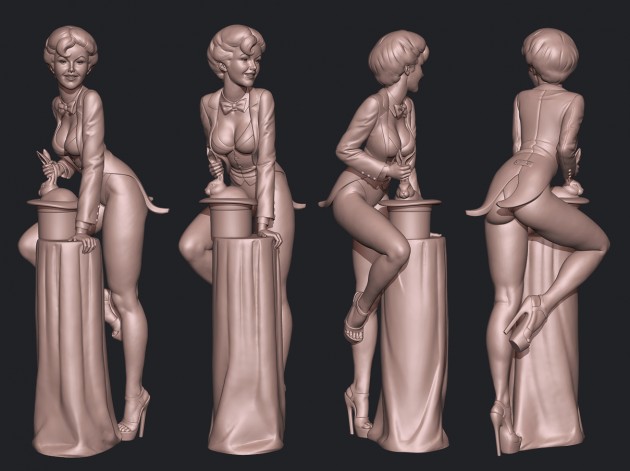

| Visitors Now: | |
| Total Visits: | |
| Total Stories: |

| Story Views | |
| Now: | |
| Last Hour: | |
| Last 24 Hours: | |
| Total: | |
Natural Girls: Designer Ben Godi’s Digital Sculpting + Pantograph Production Process

What happens when you harness the sculpting powers of of ZBrush and produce 300 wood models on a pantograph? Designer Ben Godi gives us the inside look on how he created his latest masterpiece.
Natural Girls
A little backstory on Natural Girls from our designer:
“Rush hour. The taxi had stopped a long way from the station. She is tired now from the walk and puts off her shoes and stockings. She is sitting on her luggage waiting for the half past five train. She is running away as always when things get complicated; leaving everything behind. She will begin anew somewhere else until she gets into trouble again, until she needs to take on responsibility for her life. Then she will pack her stuff and run away – as she always does.”
01: Digital Sculpting
I use Pixologic ZBrush for sculpting. It allows me to create and sculpt the model entirely on the computer; from concept to final sculpture. I’m able to change things based on client’s feedback quickly, with no need of making laborious changes on a clay model for instance. What I have to keep in mind is, that the outcome will be a physical object and in this special case, an object made out of wood. As you already know for sure, wood consists of fibers that growth in a certain direction. Therefore it’s necessary to avoid thin parts that go across that wood grain. They break easily.




02: Preparing for 3D Printing
When I’m done with sculpting, I make use of ZBrush’s “decimation master” plug-in and reduce the polycount. A super-highres mesh isn’t necessary for printing. I use Magics RP from Materialize to combine all shells to a single shell and to fix mesh errors, in case the model has any. Removing shells is necessary for giving your sculpture a wall thickness later on. In Magics RP I also perforate the sculpture, so the dispensable powder can be removed after printing.

03: Prototyping
For production on the pantograph (see point 4 below) you need to work on a reference model that is at least twice as big as the final wood figurine. That’s necessary for transferring all the small details to the wood and makes it a lot easier to work with, because you must trace the surface by hand on the profiling machine later on. But before I order the big printout for production, I go for a small version, ideally the size the final wood sculptures will be, to see how the model looks as a physical object. Whenever I feel something doesn’t look right, I go back to ZBrush and try to fix it (composition, balance…) I normally use sandstone for all of my prototype models and laser-sintered polyamide for the final piece, which get mounted on the profiling machine.


04: Production
I fill the double sized plastic 3D printout with a special resin and mount it on a metal plate. Everything has to be assembled very strong to prevent it from bending or changing its position during tracing on the machine. The tracing itself isn’t an automated process yet; you still have to do it by hand. And you have to be super careful. Oh boy, in a moment of carelessness you ruin the whole row of figures! You start with some bigger milling heads for rough machining and switch to the smaller once for detailing. I use maple wood for my work. It doesn’t change its color over the years and allows very fine details.

05: Finishing
The figures that come straight from the pantograph look great but aren’t finished yet. It needs a lot of sandpaper work to smooth the surface. I add details with my set of small carving knifes and boost the once that disappear during milling. Finally I paint the parts I want to be painted and add a thin layer of wax that prevents the wood from getting dirty.

06: Final Product
If you keep an eye on some production restrictions, (wood as a living material, the dimensions the pantograph allows, avoiding spots that are difficult to reach with the milling heads…), the possibilities are endless!


Be sure to check out Ben’s website for more information or to purchase one of these unique sculptures.
Read more about CAD, product design and related technology at
SolidSmack.com
2012-12-19 03:41:07
Source:


